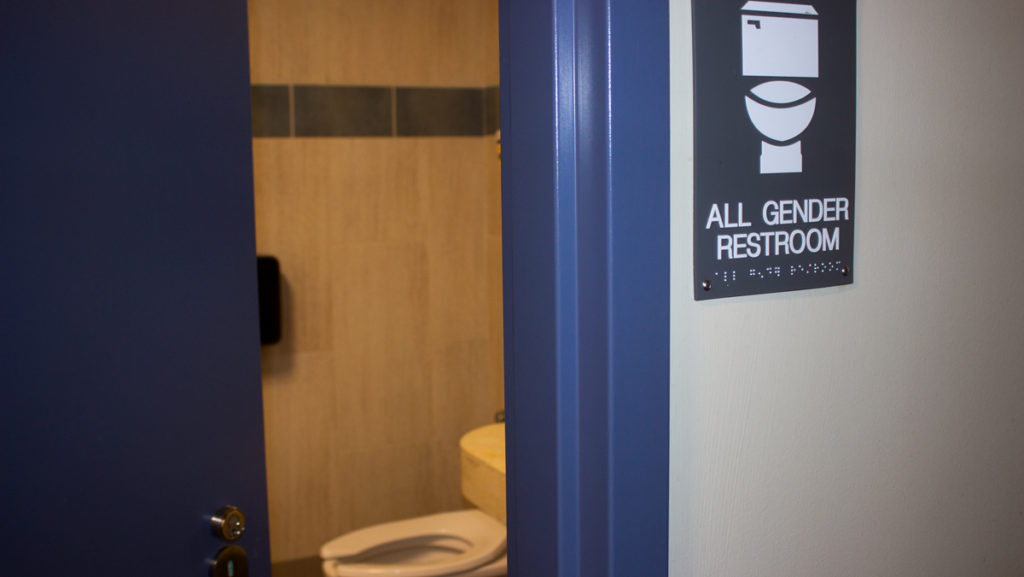In an effort to be more inclusive, Ithaca College has installed over 100 all-gender bathrooms on campus over the course of several years of renovations.
Full all-gender bathrooms include a stall, sink and shower, while half-gender bathrooms include just a stall and sink.
Tim Carey, associate vice president for the Office of Facilities, said that the college has had all-gender bathrooms since the 1990s. He said Facilities has plans to create more all-gender bathrooms as it continues to make renovations to the campus.
“As we renovate those restrooms over the course of future years, we will endeavor to replace the older restrooms with all-gender replacements wherever possible,” he said.
Carey said that while there is no specific budget for the sole purpose of creating all-gender bathrooms, the price is included in general renovations. He said the cost of creating an all-gender bathroom would in no way impact whether or not it will be created.
Freshman Rosie Robinson, who identifies as nonbinary, said the all-gender restrooms made them feel as if the college cared about their needs and was prepared to accommodate them.

“I was really happy about it because as somebody who’s off the gender binary, it made it so that I didn’t have to worry too much about where I’m going to go to the bathroom or anything like that,” Robinson said.
In the college’s residential buildings, there are currently 51 all-gender bathrooms in East Tower, 50 in West Tower, two in Emerson Hall, one in Eastman Hall, two in Garden Apartment 27, two in Lyon Hall and 21 in the Terraces Residence Halls.
There are five all-gender bathrooms in the Athletics & Events Center, two in Alumni Hall, two in the Fitness Center, seven in the Hammond Health Center, two in the Gannett Center, one in Muller Faculty Center, two in the Office of Public Safety, two in Peggy Ryan Williams Center and two in Rothschild Place.
There are two all-gender bathrooms in the Center for Health Sciences, two in the Cerrache Center, two in Dillingham Center, two in Egbert Hall, one in Job Hall, one in the Roy H. Park School of Communications, eight in the School of Business, two in Smiddy Hall, one in Textor Hall, two in the James J. Whalen Center for Music and two in Williams Hall.
Luca Maurer, director of the Center for LGBT Education, Outreach and Services, said one of his main priorities on campus was the inclusion of all-gender
bathrooms. Starting with the bathroom on the floor that his office located in the basement of the Hammond Health Center, a velcro sign was made that allowed the bathroom sign to be changed to say it was an all-gender restroom instead of just male or female.
Maurer said this has also been used for several other bathrooms around campus, including those in Terrace Dining Hall.
The second-floor bathroom in the Park School was converted from a men’s bathroom to an all-gender restroom by the addition of a lock on the door and an all-gender restroom sign in September 2018. The college was unable to create a
third bathroom in the Park School, a change that Facilities usually does to create an all-gender bathroom, because of a lack of space in the Park School, as previously reported by The Ithacan.
Maurer said the college can still improve on the number of all-gender bathrooms on campus. He said he thinks all-gender bathrooms are necessary for transgender and nonbinary students to function and to feel accepted on campus.
“I think it’s critically important,” he said. “If you can’t use the restroom, you can’t go to class, you can’t go to work, you can’t do the things you need to do on campus. It’s an issue of equity and equal opportunity to everything that our educational institution offers.”
Junior Grayson Stevens, co-president of Spectrum, an LGBTQ activism student organization, said the all-gender bathrooms are necessities not just for transgender and nonbinary students but for anyone who would like a private space where they can comfortably use the restroom.
“They are a place for trans, nonbinary and gender nonconforming students especially to feel comfortable and safe using the bathroom,” Stevens said. “They can also certainly benefit people who are cisgender as well and just need a private space to use the bathroom.”
Junior Avi Kendrick is the Spectrum social media manager. They said they personally know the importance of all-gender restrooms as someone who is transmasculine and does not feel comfortable using either the women’s or men’s restrooms.
“All-gender bathrooms are important to have on campus because I need to pee,” Kendrick said. “There are multiple buildings where I cannot use the bathroom in the building. I don’t feel comfortable going into the women’s room anymore, especially now that I appear more masculine, where I’m worried about making other people in the bathroom feel uncomfortable, but if I go into the men’s room I’m concerned about my safety and myself. So I need that space so I can go in and not have to worry about either of those things.”
Freshman Patrick Kuehl said he thinks all-gender bathrooms that were converted from men’s or women’s bathrooms and have multiple stalls should allow more than one person to use them at a time. He said he feels this way because he has waited for long periods of time to use the all-gender bathroom on the second floor of the Park School.
“Even though all gender bathrooms should be included in all bathroom schemes, it is silly to turn the men’s bathroom virtually into a single bathroom,” Kuehl said. “In reality, the all-gender bathrooms should just be a normal bathroom with multiple stalls, not a single.”








